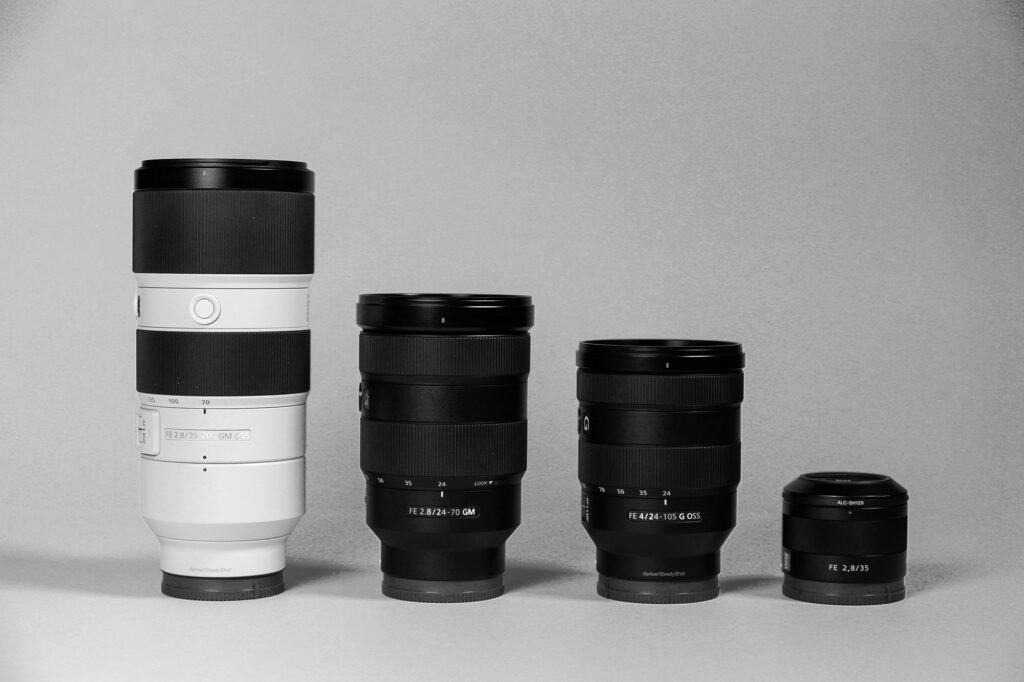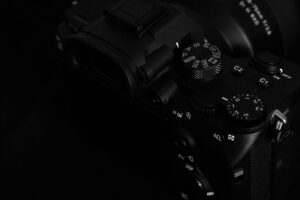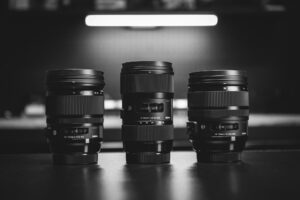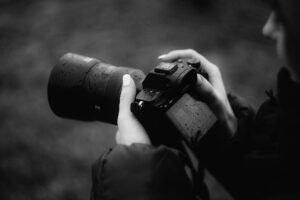Choosing the right lens can have a bigger impact on your photography or video than upgrading your camera body. But with so many lens types out there -from wide-angle to telephoto to special-purpose lenses- it can get overwhelming fast. In this post, you’ll get a clear breakdown of the different types of camera lenses, what each one is best suited for, and how to decide which type matches your creative needs. Whether you’re just starting out or looking to expand your lens kit, this guide will help you make a smarter decision.
TL;DR
- Ultra-Wide Lenses: Focal lengths under 24mm, great for dramatic perspectives, interiors, and tight spaces. Often include distortion.
- Wide-Angle Lenses: Typically 24-35mm, ideal for travel, architecture, and landscapes.
- Standard Lenses: Around 35-70mm, offering a natural field of view. Excellent for everyday use and street photography.
- Short Telephoto Lenses: Between 70-105mm, especially good for portraits with pleasing background blur.
- Telephoto Lenses: Over 105mm, perfect for wildlife, sports, and isolating distant subjects.
- Macro Lenses: Designed for close-ups with fine detail, often used in product, nature, or scientific photography.
- Tilt-Shift Lenses: Specialized for architectural or product work, allowing perspective and plane-of-focus control.
- Pancake Lenses: Compact and lightweight primes, ideal for travel or casual street shooting.
This post is just one part of my “Lens Buying Guide“, which you can download as a pdf file right now.
1. Ultra-Wide Lenses: Capture More in the Frame
Any lens with a focal length shorter than 24mm is considered an ultra-wide lens. These lenses allow you to capture an extremely broad view of the scene, sometimes even up to 180 degrees.
Fisheye lenses are a special sub-type of ultra-wide lenses, typically ranging between 8mm and 14mm. They create dramatic distortion, curving the edges of the image to fit more into the frame.
While some distortion (also known as barrel distortion) is common in all ultra-wide lenses, it’s especially exaggerated in fisheye lenses. For non-fisheye ultra-wide lenses, distortion is usually mild and can be corrected during editing if you shoot in RAW format.
Theses types of lenses are best for landscape photography, architecture, creative compositions, and tight indoor spaces.
2. Wide-Angle Lenses: Great for Travel and Landscapes
Wide-angle lenses usually have a focal length between 24mm and 35mm. Many kit lenses start from this range. Compared to ultra-wide lenses, they have a narrower field of view and less distortion, but they still capture a significant portion of the scene.
These lenses are a great all-purpose choice for both photography and video, especially in travel, events, and documentary work.
Not all wide-angle lenses are created equal, so it’s worth learning how to judge lens sharpness and optical quality before buying.
3. Standard Lenses: The Most Versatile Option
Standard lenses fall in the 35mm to 70mm range. A 50mm lens on a full-frame camera is often considered to replicate the field of view of the human eye, which is why it’s called a “normal lens.”
Prime lenses in this category -like the popular 50mm f/1.8- are widely loved for their sharpness, shallow depth of field, and affordability. They’re ideal for a wide range of genres including portrait, product, and street photography.
4. Short Telephoto Lenses: Ideal for Portraits
Lenses with focal lengths between 70mm and 105mm are referred to as short telephoto lenses. They allow for moderate zoom and a more compressed look than standard lenses.
These lenses are excellent for portrait photography, as they create flattering facial proportions and beautiful background blur (bokeh). Many photographers consider this range the sweet spot for headshots and upper-body portraits.
5. Telephoto & Super-Telephoto Lenses: Zoom in on Distant Subjects
Telephoto lenses cover the 105mm to 300mm range. They let you capture distant subjects with impressive magnification and detail. However, they are generally larger and heavier than shorter lenses.
Anything beyond 300mm is often classified as a super-telephoto lens. These are commonly used in sports, wildlife, and bird photography, where getting physically closer isn’t possible.
Due to their narrow field of view and subject compression, telephoto lenses are great for isolating subjects and creating dramatic depth.
If budget is tight, you might consider buying a used lens to save money without losing quality.
6. Special-Purpose Lenses: Tools for Unique Shots
6.A. Macro Lenses for Close-Up Details
Macro lenses usually have focal lengths between 40mm and 200mm, and are designed to focus very closely on small subjects. They provide a 1:1 magnification ratio, meaning the subject appears life-size on the camera sensor.
They’re ideal for capturing intricate details of insects, flowers, textures, or any subject where close-up precision matters.
6.B. Tilt-Shift Lenses for Perspective Control
These are niche, high-end lenses used primarily in architectural and product photography. Tilt allows the focus plane to be adjusted, so you can keep more (or less) of the image in sharp focus without changing the aperture. Shift lets you move the lens relative to the sensor, helping to correct perspective distortion (like converging vertical lines in buildings).
Tilt-shift lenses don’t offer autofocus and require a deep understanding of manual focus and framing, but in skilled hands, they produce stunningly precise results.
6.C. Pancake Lenses for Portability
Pancake lenses are ultra-compact prime lenses with a slim, flat design, often in the 24mm to 40mm range. While not a separate category in terms of focal length, they deserve a mention because of their portability and light weight.
They’re perfect for travel, street photography, and everyday use, especially when you want to keep your camera setup discreet and minimal.
Reminder: This post is just one part of my “Lens Buying Guide“, which you can download as a pdf file right now.
Last Words
Lenses aren’t just tools, they shape your creative voice. Each type of camera lens brings a different look, feel, and technical advantage to your photography or video work. By understanding the strengths and use cases of ultra-wide, standard, telephoto, and specialty lenses, you’ll be better equipped to build a lens kit that grows with your skills. Start with what matches your current needs, and expand as your creative direction evolves.
FAQ
What are the main types of camera lenses?
The most common types are prime lenses, zoom lenses, macro lenses, wide-angle lenses, telephoto lenses, cinema lenses, and specialty lenses like fisheye or tilt-shift.
Which type of lens is best for beginners?
A versatile zoom lens, such as an 18-55mm kit lens, is a good starting point for most beginners.
Can one lens work for all types of photography?
No single lens covers every situation perfectly, but some all-in-one zooms can handle a wide range of subjects.




